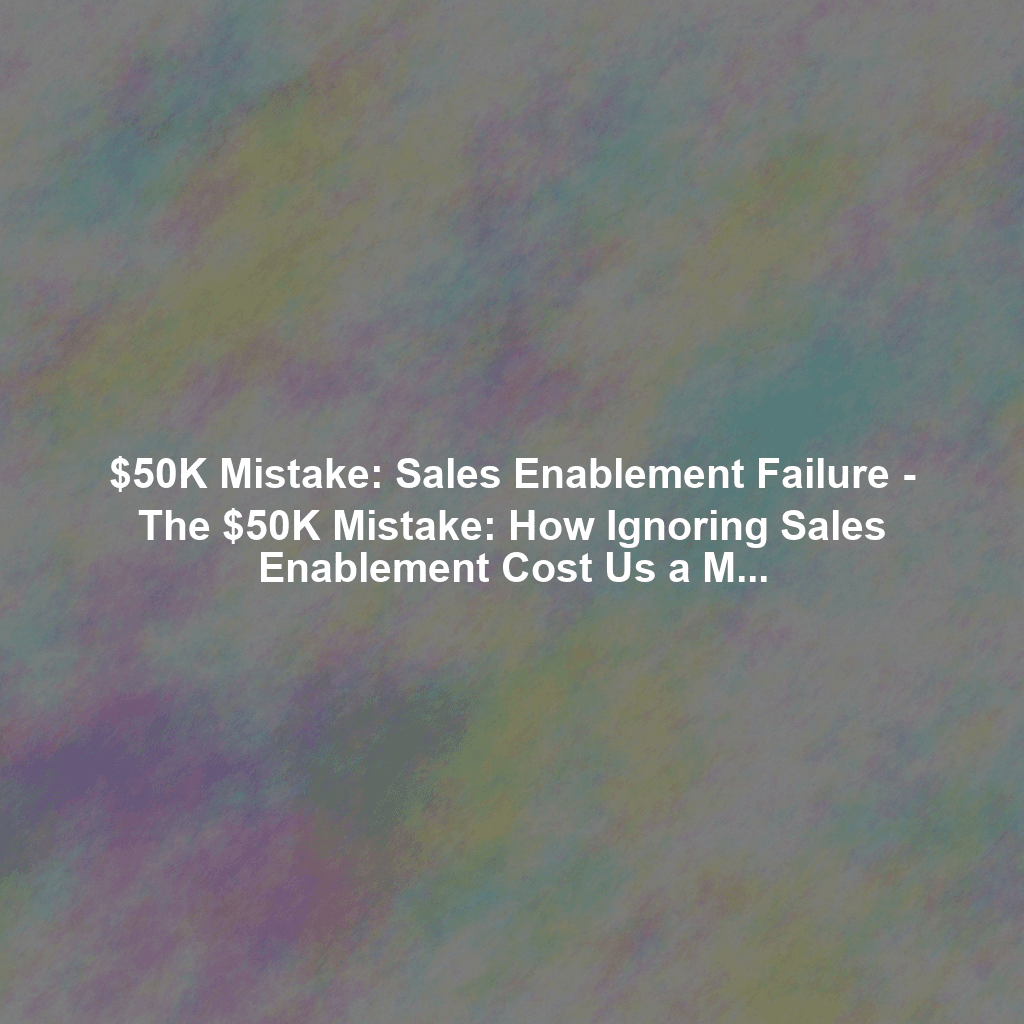In the fast-paced world of B2B lead generation, every detail matters. We learned this the hard way. We thought we had a winning product, a strong sales team, and a solid pipeline. But a crucial element was missing: robust sales enablement. This omission ultimately cost us a major deal, forcing us to re-evaluate our entire approach. This is the story of how ignoring sales enablement directly led to a $50,000 mistake and, more importantly, how we turned that mistake into a valuable lesson.
The Promising Lead: ACME Corporation
ACME Corporation, a mid-sized manufacturer, was exactly the type of client we were targeting. They were looking to upgrade their legacy CRM system, and our cloud-based solution was a perfect fit. The initial contact was promising. Their VP of Sales, Sarah, was impressed with our demo and expressed a strong interest in moving forward.
Our sales rep, Mark, was confident. He’d handled similar deals before and felt he had a good rapport with Sarah. He diligently followed up, answered her questions, and provided her with a customized proposal.
The Slipping Away: Where We Went Wrong
Despite the initial enthusiasm, the deal started to stall. Sarah became less responsive, and Mark found it increasingly difficult to get her on the phone. We couldn’t figure out what was going wrong. Looking back, the cracks were appearing due to critical failures in our sales enablement strategy:
Lack of Targeted Content
Mark was using generic marketing materials, instead of customized content tailored to ACME Corporation’s specific needs and industry. While the proposal addressed their general CRM needs, it failed to highlight how our solution specifically addressed the unique challenges faced by manufacturers of their type. We didn’t provide content that demonstrated a deep understanding of their business.
Inadequate Training and Support
Mark, like the rest of the sales team, hadn’t received adequate training on how to effectively communicate the value proposition to specific industries. He could talk about the features, but he struggled to translate those features into tangible benefits for ACME. He lacked the industry-specific knowledge needed to address Sarah’s concerns with authority and confidence.
Missing Competitive Analysis
We didn’t arm Mark with a comprehensive competitive analysis tailored for the manufacturing industry. ACME was evaluating multiple solutions, and Mark couldn’t effectively differentiate our offering from the competition beyond superficial feature comparisons. He couldn’t confidently articulate why our solution was superior for *their* specific needs.
The Blow: Losing the Deal
The inevitable happened. Sarah informed Mark that they had decided to go with a competitor. The reason? The competitor’s sales team had demonstrated a deeper understanding of their business and had provided more compelling evidence that their solution could deliver the results ACME needed. The deal, valued at $50,000 in annual recurring revenue, was lost.
The Wake-Up Call: Implementing Sales Enablement
Losing the ACME deal was a painful but necessary wake-up call. We realized that we couldn’t rely solely on our product and sales team’s individual skills. We needed a structured approach to equip our team with the knowledge, tools, and resources they needed to win deals.
We invested heavily in building a robust sales enablement program. Here’s what we did:
Content Creation and Curation
- We developed industry-specific case studies, white papers, and blog posts that addressed the unique challenges faced by our target industries.
- We created a centralized content library that was easily accessible to the sales team.
- We established a process for regularly updating and refreshing content to ensure it remained relevant and accurate.
Sales Training and Coaching
- We implemented ongoing training programs that focused on product knowledge, sales skills, and industry expertise.
- We provided sales reps with access to coaching and mentorship from experienced sales leaders.
- We used role-playing exercises to help reps practice their sales pitches and handle objections.
Technology and Tools
- We invested in a sales enablement platform that provided reps with access to the right content at the right time.
- We integrated our CRM system with our sales enablement platform to track content usage and measure its impact on sales performance.
- We provided reps with access to tools for creating personalized presentations and proposals.
Measuring and Optimizing
- We tracked key metrics such as content usage, sales cycle length, and win rates to measure the effectiveness of our sales enablement program.
- We regularly reviewed these metrics and made adjustments to our program as needed.
- We solicited feedback from the sales team to identify areas for improvement.
The Results: A Turnaround
The results were immediate and significant. Within a few months, we saw a noticeable increase in our win rates and a decrease in our sales cycle length. The sales team felt more confident and empowered, and they were better equipped to engage with prospects and close deals.
We even managed to win back a similar deal with another manufacturing company, using the tailored content and industry knowledge we had developed. The $50,000 mistake became a catalyst for positive change.
Conclusion: Sales Enablement is Non-Negotiable
Our experience with ACME Corporation taught us a valuable lesson: sales enablement is not optional; it’s essential. In today’s competitive B2B landscape, a strong product and a skilled sales team are no longer enough. You need to empower your sales team with the right knowledge, tools, and resources to effectively engage with prospects, differentiate your offering, and close deals. Ignoring sales enablement can be a costly mistake, but investing in it can pay off handsomely in the long run.


